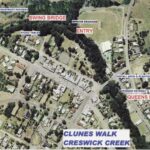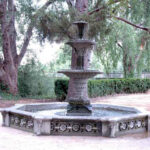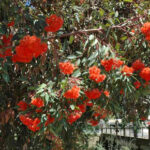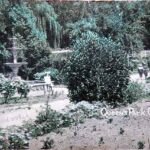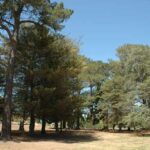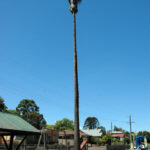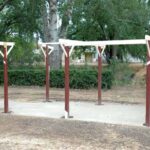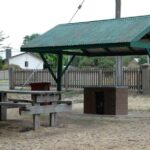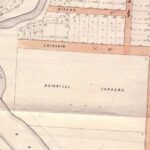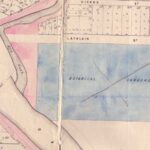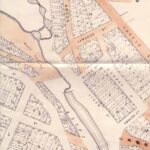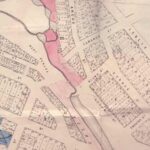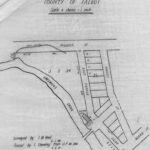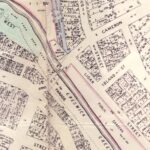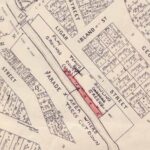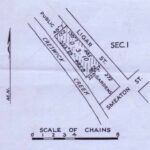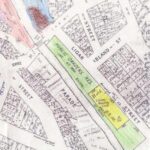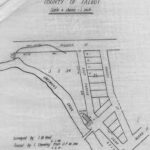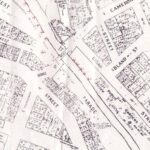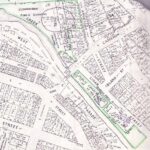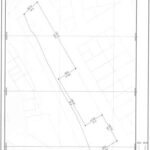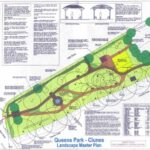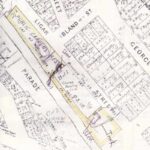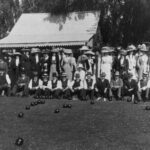Queens Park
Queens Park in Clunes
Queen’s Park is located on Ligar Street, just to the east of the town centre, on the other side of Creswick Creek. The exact age of the park is unknown, but trees were being planted there in the mid-1870s. Originally it ran the whole length of Ligar St, but in 1878 the Clunes Bowling Club was set up in the middle of the park and later formally excised from it. The remaining park was divided into two sections: a formal pleasure gardens of flower beds, trees and a fountain to the north of the bowling club; and a pinetum to the south, where there was also a wooden platform for entertainments.
The pleasure gardens no longer contain their beds of annuals, roses and dahlias, but several excellent trees remain. Three of these, a Blue Atlas Cedar (Cedrus atlantica f. glauca), a Fastigiated Blue Atlas Cedar (Cedrus atlantica “fastigiata”) )and a Spanish Fir (Abies pinsapo) are on the National Trust’s Register of Significant Trees. There is also a very tall palm (Washingtonia robusta) which stands out by virtue of having been surrounded by a modern playground, and several large White Poplars (Populus alba) along the creek. The fountain, built to celebrate Queen Victoria’s golden jubilee in 1887, has recently been restored. Some of the original paths have been renovated as part of the Creswick Creek Walkway. A new pergola has been erected, a covered barbecue area and other improvements are planned. There are several information boards within the park.
The pinetum, being separated from the more picturesque end of the park, is somewhat neglected. The trees here are younger than the feature trees in the pleasure gardens and probably date from around the time of the First World War.
It has been claimed that Queen’s Park is more than a mere park: it is one of around twenty botanical gardens established in regional Victoria in the mid to late 1800s. Throughout the 130 or so years of its life, it has merely been referred to by the locals as a park or a reserve and was not seen as a formal collection plants. Certainly, it lacks most of the attributes expected of a botanical garden. But to argue this point is academic. It is a garden with a long history (in Australian terms) and is worthy of conservation and future development. A visit to Clunes would not be complete without a walk in Queen’s Park.
Roger Cousens, Melbourne University, was the author of all material relating to Queen’s Park. Much of the historical material was researched by Stephanie Stott, Abby Carmichael and Jeanette Spittle while studying for their Bachelor of Horticulture at the Burnley Campus of the University of Melbourne. Greg Leece helped by providing access to DSE records. Thanks also go to Pat Cook of the Clunes Museum and to Ron Hateley, Clunes resident. Changes last made 3 June 2007.
History of Queen's Park
Gold was discovered in Clunes in 1851 by James Esmond. The goldrush that followed saw the establishment of the town, from temporary tents and shelters to permanent stone dwellings, shops, banks, the grand town hall and churches. The town was formally surveyed in 1858 by John Templeton and in 1863 by Hugh Fraser, the Assistant Surveyor. Fraser Street and the adjacent roads were gazetted in 1866.
Queen's Park Caretakers
At various times the gardens have been looked after by a caretaker, with other council workers being drawn on for maintenance work.
In 1887 Mr Cairns and George Squires were accused by the town clerk, Mr Hobson, of taking twice as long as it should to paint the seats in the park; Squires was also accused of using insulting language and to being assaulted. He was taken to court, fined and imprisoned in Ballarat Gaol for two weeks because he could not pay the fine. Mr Harris was superintendent of planting in the Borough in 1872. The first caretaker mentioned in council minutes was Mr Fry, who requested a pay rise in 1885. After the death of the caretaker in 1895, Robert Crawford was selected from 11 applicants. Although well-received at first, reports of his work were later highly critical. In 1899 M. Davey was selected from 8 applicants. Although paid for only three days work per week, Mr Davey worked for 5 days per week. In 1908, Mr Davey fell ill and died. Mr Richardson, curator of the bowling club, helped look after the park until the new caretaker, William Webb was appointed (from 4 applicants). Mr Webb received a pay rise in 1914; he worked 3 days per week. His services were terminated in 1917, when the foreman (Mr Ford) took over the duties. Mr Ford resigned in 1920, with his duties being taken over by the assistant foreman, Mr Purcell. In 1927 Mr F. Preston volunteered to be caretaker of both Queen’s Park and Victoria Park for only £10 per year.
The Fountain
As part of the Queen Victoria 50th jubilee celebrations in 1887, Councillor Edwards proposed that a commemorative fountain should be placed in what was then the Creek Reserve. It was anticipated that this could be done within a budget of £50. Fountains were inspected at Ballarat and Maryborough. Arthur Batson, the former town clerk then working in Fitzroy sent a design based on the fountain in the Exhibition Gardens in Melbourne and this was approved by council (note that the Clunes fountain shows very little resemblance to the fountain outside the Royal Exhibition Building). The contract to the fountain was given to Waugh Bros. Foundry in Collingwood, at a price of £63. It was to consist of two tiers and constructed “of pressed cement, standing in a suitable basin of the same material”. There is an inscription on the fountain, now becoming difficult to read, “1887 – Erected by the burgesses of Clunes, as a memorial of affection and loyalty on the completion of the fiftieth year of the reign of Her Majesty, Queen Victoria. J. E. Meyers, Mayor”. It was proposed to have a fence around the fountain, but this appears never to have been built due to lack of funds. The opening of the fountain was held in June 1887. The fountain appears in almost every photograph of Queen’s Park and was clearly a focal point.
The fountain proved difficult to maintain, requiring frequent painting and often cracking. As soon as 1890, the Town Clerk noted the “dilapidated appearance” of the fountain and £4-5 was allocated for three coats of paint. A crack in the fountain was noted in 1891. Restoration work on the fountain was again needed in 1899, when the fountain was reported by Councillor Martindale to have been “in a very bad state”. Other repairs were made in 1915, 1923, 1925 and 1929 (at the present time, historical research has only covered the years to 1930).
There were goldfish in the fountain in 1894, when the youngest son of the postmaster fell into the fountain trough and gashed his forehead! In 1915 requests were made for goldfish to be put into the fountain. At various times, councillors complained about children playing in the fountain (presumably this indicated that due reverence was not being paid to the former queen?). However, at one point it was proposed that the water in the tank around the fountain could be used by the gardener when piped water was not available (supply of water to the gardens was an issue for many years).

The Fountain – “1887 – Erected by the burgesses of Clunes, as a memorial of affection and loyalty on the completion of the fiftieth year of the reign of Her Majesty, Queen Victoria. J. E. Meyers, Mayor”
"Botanic Gardens" Reserve
The town plan of 1863, resulting from Assistant Surveyor Hugh Fraser’s survey of the town, shows a 30 acre site for a botanic garden on the southern outskirts of the town, along MacDonald St. It had been “temporarily reserved” (Rs 9945) as a site for public gardens and formally gazetted by the State Government on 20 January 1863. It is unclear who made the decision to reserve the block for this purpose. It is also difficult to understand how anyone could have pictured this infertile, windswept block as being transformed into a botanical oasis. There was never any attempt to develop the block as a garden. From at least 1876 it was used as a public pound. In 1883 the council gave permission to the Bute & Downes company to mine the site, but this would appear not to have happened. In 1899 the local MP, A. J. Peacock, advised council that they should not quarry stone from the site, since that would contravene the terms of the reservation. Council thus decided to apply to have the reservation changed to a quarry, but again this did not occur.
In 1920 the council turned down a request from a returned soldier to purchase the land. In 1933 the block was fenced in half, with the pound-keeper paying £10 per year to graze his own animals, with the other half continuing to be used as a pound. A nominal rent appears to have been paid by the Borough of Clunes for “permissive occupancy” of the land “for pound purposes”. In 1991, the State Government reviewed the status of the block and in 1994 the temporary reservation as a public garden was formally revoked (Government Gazette 15 December 1994). Although at the present time there is a small clump of pines on the northern boundary, there is no evidence that the block was ever developed as a botanic garden or any sort of park.
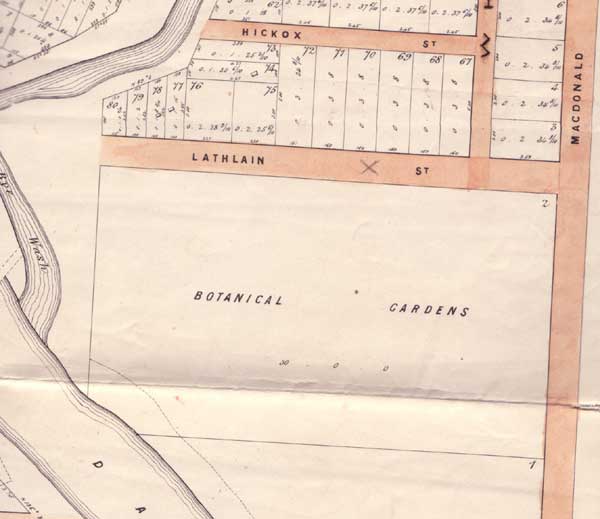
Town plan of 1863
A Short History of Clunes Bowling Club
The bowls club was inaugurated in 1878 and the Town Clerk and Surveyor, Arthur Batson, laid out the greens. Although there was some early concern about the annexing of land in the middle of the public reserve for a private club, the club has been very popular over the years and became an integral part of the town. By the end of the 19th century a pavilion had been erected (approved by council in 1882) and the greens renovated and extended. Films were shown at nights as a fund-raiser for the club. By 1912 the club was able to play bowls at night, under gas and acetylene lights. In those early days the membership was entirely male, with ladies providing refreshments. Membership of ladies was proposed as early as 1899, but it was not until 1921, with drastically declining membership, that nine ladies were allowed to join for half the usual subscription fee. In 1924 the Ladies Croquet Club was also using the greens. A Ladies Bowling Club was formally started on 20 October 1927 and the ladies contributed considerably to the state of the pavilion and in raising funds. The present clubroom (see photo on the right) was built in 1965. The men’s and ladies clubs formally merged in May 1987. Early photographs of the club can be seen on the gallery.
It would appear that for much of the early life of the bowls club the land was not reserved for that use: the whole of the reserve was temporarily reserved in 1887 as “public gardens”. This was rectified in 1963, with that reservation being revoked for an area of 3 roods 10 perches for the bowls club. Over the years the greens have been shaded by large trees along its borders and poplar suckers have been a recurring problem. In 1887 gum trees were removed to facilitate the growth of pines between the club and Ligar St. Trees have been removed at various times since that date, between the creek and the club and outside the southern boundary of the club. Recent removals have resulted in articles and letters of complaint in the newspaper. While blame was laid on the club, acting outside its authority (the club had also appropriated the old tennis court as a car park and built a shed outside its southern boundary), it would appear that the correct formal channels had been followed. However, the bowls club now effectively cuts the reserve in two, isolating the southern “pinetum” from the rest of the gardens. The result is that Queen’s Park to most people is merely the northern area containing the fountain.
Roger Cousens, Melbourne University, was the author of all material relating to Queen’s Park. Much of the historical material was researched by Stephanie Stott, Abby Carmichael and Jeanette Spittle while studying for their Bachelor of Horticulture at the Burnley Campus of the University of Melbourne. Greg Leece helped by providing access to DSE records. Thanks also go to Pat Cook of the Clunes Museum and to Ron Hateley, Clunes resident. Changes last made 3 June 2007.


